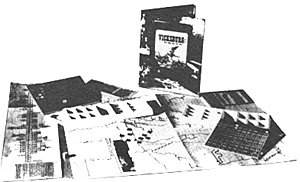
This game was researched, designed and developed by the Morningside Game Project (Jim Cumbo, Al Nofi and John Prados) and published by Rand Game Associates. Due to an economic retrenchment at Rand it now comes in a clear plastic zip-lock bag. This contains: a 21"x 28~" mapsheet printed in blue and brown on tan heavy paper); a 7"x8/" and a 6/"x7" sheet of /"-square unit counters with rounded edges (Confederate black on grey, Union black on blue, misc. markers black on light blue); a 9"xll", 12-page (counting covers) rules booklet; an 8 1/2"xll" sheet of historical background; and a 6/"x27/" Time Record Chart/Order of Appearance Table.
The map covers the area from just above Cairo, Illinois to Baton Rouge, Louisiana, and from just west of Little Rock to Birmingham, Alabama. The Terrain Effects Chart (TEC) covers the southeast corner of the map (southeast of Meridian, Miss.) and the northwest corner (southwestern Missouri) contains the Combat Results Table (CRT). Terrain types include clear, minor river, Yazoo River, major river, bluff, marsh, railroad, bridge, town, and supply center. State lines are also indicated on the map. Unit counters represent Union infantry, garrison and cavalry divisions and garrison and cavalry brigades, river forces (gunboats), and naval force, and Confederate infantry and cavalry divisions and brigades, batteries (heavy artillery) and river forces. Both sides have supply depot counters. There are also counters for canals, breaks in railroads and forts.
This is a fairly conventional, divisionlevel, hex-grid board game: two players alternate moves. Ground units have zones of control (ZOC), but these don't require enemy units to stop, only to expend an extra movement point. Attacking is always optional or voluntary, never required. River and naval units, batteries and ground combat units in forts have a "range of effectiveness". This is like a ZOC only it extends into adjacent hex sides, because river and naval units only move along hex sides, as in Avalon Hill's 1776.
The supply rules are complex and very important to the play of the game. The Union player must be able to trace a supply line to any one of: any part of Illinois, the north edge of the board or the southern end of the Mississippi River, or to a friendly Supply Center. The Confederate player must be able to trace a supply line to either the western or eastern edge of the board or to a friendly Supply Center. The Supply Centers are: Cairo, Nashville, Memphis, Meridian, Vicksburg, and Port Hudson. Normally supply lines are only allowed to be three hexes long, however it can be extended by utilizing railroads, river supply transport units or supply depot counters. A unit may trace its supply line to one of these, as long as they in turn, are in supply. Ground combat, except for being optional, is quite conventional. Players may always reorganize their infantry units into larger units taken from the dead pile. River forces may each perform any one of the following missions on a given turn: bombardment, gunfire support, naval action, patrol (try to prevent Confederates from crossing a major river), transport troops, transport supplies.
There are four "Situation Games": Grant Moves South (Nov 1861-April 1862), Confederate Counteroffensive (Aug-Dec 1862), Down the Mississippi (Dec 1862-April 1863) and Battles Around Vicksburg (AprMay 1963) - and two Campaign Games: The War For the West (Nov 1861-Aug 1863) and the Vicksburg Campaign (Dec 1862-Aug 1863). Each of these is complete in itself and each has four possible variants. In each game the players may choose to play according to the rigid initial placement instructions accompanying the Situation Outline. The players may also choose to deploy according to the directions on the Free Set-Up Deployment Map which accompanies the Situation Outlines. Finally, one player may deploy according to the rigid initial placement and the other according to the free set-up Once in each game, or twice in "The War for the West", the Confederate player is permitted to send off the eastern edge of the map up to 20% of his ground combat strength. The Union player must then send twice as many combat factors within two turns. This simulates a Confederate offensive such as Bragg's into eastern Kentucky.
If you're interested in Civil War games, or strategic-level games you could do a lot worse than this one. It's the best Civil War game I know of, besides my own Atlanta. It sells for $8.50 and is available by mail from us, Panzerfaust Publications, P.O. Box 896, Fallbrook, CA 92028. As you'll see by our ads, we are carrying four other Rand games. I'll have reviews of some or all of the rest in the next issue. In physical format they are all about the same as this one, which is about equal in quality to most SPI, GDW and SDC games.
Thumbnail Analysis
-
Game Review: Vicksburg
Game Review: East Front (WWII)
Game Review: Siege of Jerusalem 70AD
Game Review: Madame Guillotine
Game Review: Palace of the Vampire Queen
Game Review: Airborne (WWII)
Game Review: Poland (WWII)
Game Review: Basic Fighter Combat Manual (WWII)
Game Review: Hex Sheet
Back to Campaign # 77 Table of Contents
Back to Campaign List of Issues
Back to MagWeb Master Magazine List
© Copyright 1977 by Donald S. Lowry
This article appears in MagWeb.com (Magazine Web) on the Internet World Wide Web. Other military history articles and gaming articles are available at http://www.magweb.com